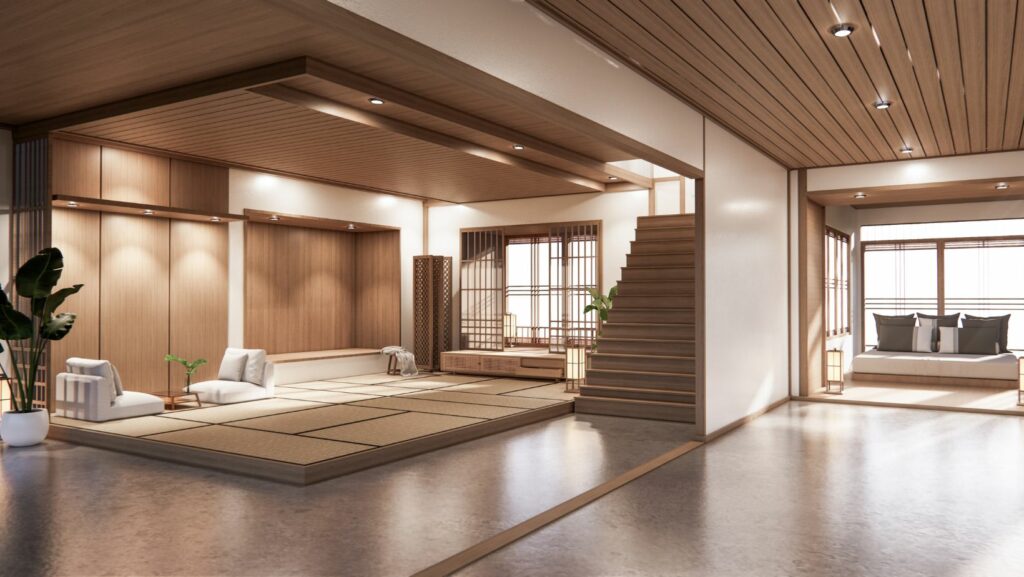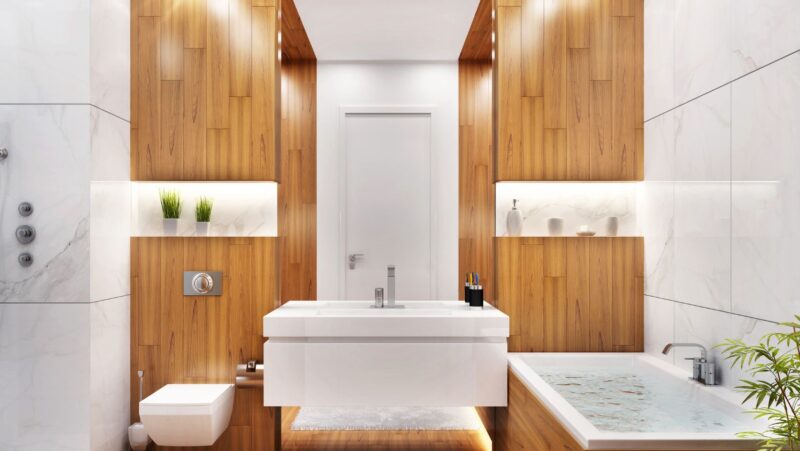
Gaining popularity over recent years, industrial interior design is unique for its raw and rustic aesthetic. Originating from repurposed industrial spaces, this style has now found its way into residential homes, creating a distinct and edgy atmosphere.
Furniture
Choosing the right furniture, even with virtual staging, can immediately set the tone for an industrial interior. You’ll want to use pieces that show off raw materials like metal, reclaimed wood, and distressed finishes. Iconic industrial furniture includes steel-framed tables, rustic wooden chairs, and metal shelving units. The furniture pieces often feature clean lines and minimalistic designs; there’s an emphasis on functionality over extravagance. Keep an eye out for furniture with visible hardware, such as exposed bolts or rivets, which add to the industrial charm. Consider incorporating vintage or salvaged items to create a historical and authentic atmosphere. Don’t forget to mix textures and materials too!
Wallpaper
You should consider using exposed brick or concrete wallpapers to simulate the raw, unfinished look of industrial spaces. These give you a quick and effortless way to add texture and depth to your walls without the need for actual exposed brick or concrete.
Alternatively, you could use mural wallpapers featuring machinery or urban landscapes to give your home a touch of realism. These murals can be a focal point within your space, drawing the eye and adding visual interest.
Experiment with different patterns and designs to find the perfect wallpaper for your industrial aesthetic.
Flooring
Industrial flooring should mirror the robust nature of the design style.
Polished concrete floor is a popular choice for industrial interiors as it offers durability and a sleek, modern appearance. Distressed wood flooring is another choice that adds character and elegance to your home.
Alternative budget-friendly options include industrial-style tiles in shades of grey or neutral tones to mimic the look of concrete and engineered wood flooring, both of which provide durability.
If you want to soften the industrial edge, consider incorporating rugs with geometric patterns or distressed finishes. These will complement the industrial aesthetic, whilst adding warmth and texture to your floors.
Decoration
You can incorporate industrial-themed décor elements to really enhance the aesthetic and ambience of your home.

Consider vintage signs, metal wall art and salvaged industrial pieces like gears or pulleys to create visual intrigue across your space. Embrace items with imperfections and wear and tear as they contribute to the authentic charm of industrial design.
Mix old and new décor together, creating a curated look that tells a story. You can repurpose vintage items or DIY projects to add a personal touch too. Industrial-style shelving units or display cabinets can be used to highlight your collections of books, artwork or other cherished items. This is a simple way to add to your industrial vibe!
Lighting
A unique part of industrial design is its ability to turn simple elements into eye-catching statement pieces. Consider pendant lights with exposed bulbs, reminiscent of factory fixtures; using sconces and floor lamps also contributes to the industrial aesthetic.
Industrial buildings also feature large natural windows; take advantage of this as it allows a lot of natural light to flow into your home.
Color
Industrial design typically revolves around a neutral color palette; greys, blacks, and browns. These colors provide a neutral backdrop for the raw materials and textures characteristic of industrial interiors.
You can introduce pops of color through accessories like throw pillows, rugs, or wall art – just don’t go overboard!
Consider including metallic accents throughout your space to add shine and contrast; think copper, brass, or brushed nickel. These finishes can be used in lighting fixtures, hardware, or decorations to create a cohesive and polished look.
Try experimenting with different combinations of colors and finishes to find the perfect balance for your home.
Raw Materials
To truly capture the essence of industrial interiors, you should include raw materials throughout your home. Exposed brick walls, concrete surfaces, and unfinished ceilings can create an authentic backdrop for this design. Incorporate elements like steel beams or ductwork to emphasise the industrial aesthetic further.

Reclaimed wood is another key material in this design. It can be used for flooring, furniture, or even accent walls to give your home a rustic charm. Salvaged materials such as corrugated metal or vintage doors can add texture and visual interest to your space.
Open Spaces
A key feature of industrial design is the use of open floor plans, which create a sense of spaciousness and connectivity. If and where possible, consider removing unnecessary walls to achieve an open layout. You can use furniture and décor strategically to define different areas within the space whilst maintaining a cohesive design.
ou can incorporate industrial-style room dividers or partitions to create separation without sacrificing the open feel of your space. Sliding barn doors, metal-framed glass partitions, or black steel doors can add architectural interest, all while keeping to the industrial aesthetic.
Experiment with different layouts to maximise the flow and functionality of your home.
Incorporating Greenery
You can balance the hardness of industrial design by incorporating greenery into your home. Use large potted plants or even industrial-style plant stands to bring a touch of nature to the raw aesthetic. Whether you’ve got green fingers or are a plant killer, consider low-maintenance plants like succulents or ferns to add a refreshing element to the industrial vibe without overwhelming it.
Vertical gardens or living walls are another creative way to bring nature inside. These green installations can serve as focal points within your space; adding colour, texture and visual interest.
Play around with different plant species and arrangements to create a lush and inviting environment that complements your industrial home.



